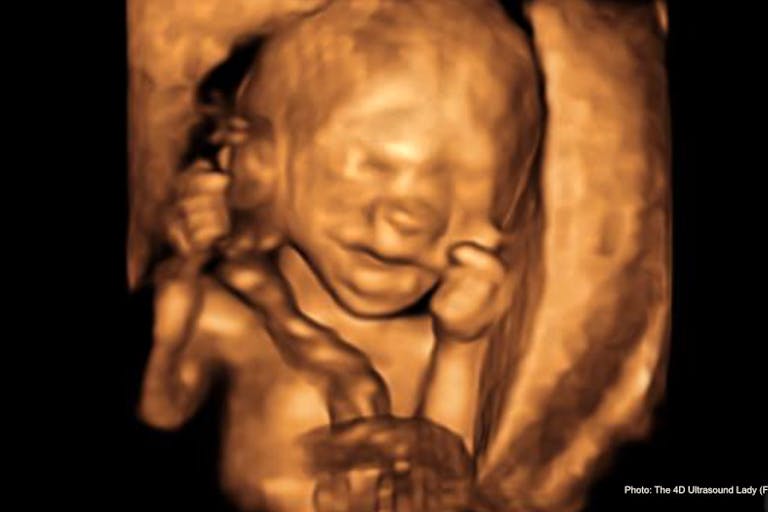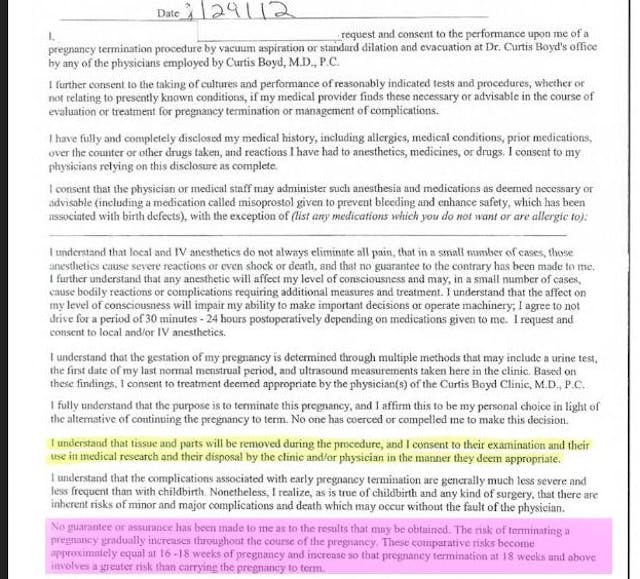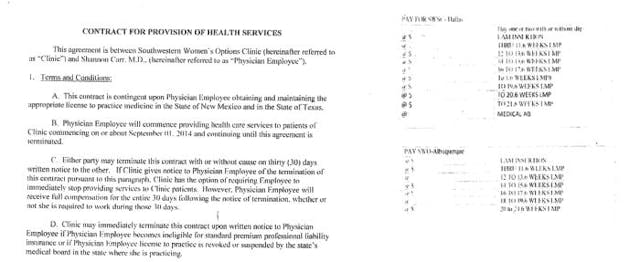
Decades after banning the death penalty, Canada kills inmates by 'assisted suicide'
Nancy Flanders
·
Late-term abortionist’s document: Carrying to term safer for women than abortion at 18+ weeks
The later a woman seeks an abortion in pregnancy, the more dangerous it is — as even infamous (now retired) late-term abortionist Curtis Boyd — who has ended the lives of an estimated 250,000 preborn babies — openly stated on one of his abortion patient consent forms.
This Live Action News series on late-term abortion (abortion late in gestation) will document that committing these procedures — specifically, later induction abortion in an outpatient abortion facility — fails to meet the standard of care and could result in more women being harmed.
Despite this disregard for the standard of care, some states are using taxpayer funding for late-term abortions.
Regardless of any “standard of care” in the realm of abortion, ending the life of a preborn baby is still intentional killing, regardless of where it is performed — and it is wrong to kill an innocent human being.
Late-term or later abortion is fraught with risks for the woman; abortion becomes riskier as her baby’s gestational age increases.
The location of a late-term abortion cannot make it safe; killing an innocent human being is not “safe” for that individual — and in this case, the mother’s safety is at risk, too.
Retired late-term abortionist Curtis Boyd, who owned Southwestern Women’s Options, stated on one of his facility’s consent forms that abortion at 18 weeks or later “involves a greater risk than carrying to term.”
A hospital was accused of “negligence” for referring a woman to Boyd’s abortion facility to undergo an elective abortion at 24 weeks pregnant; she died as a result.
Medical malpractice attorney Mike Seibel — who previously won a lawsuit against Boyd in the abortion-related death of 23-year-old Keisha Atkins — stated in an interview with Straight Talk on Life Issues:
The standard of care is that they should be done in a hospital or hospital-like setting…. It’s very risky to do a late-term abortion past 25/26 weeks. Once you get into that area, even Curtis Boyd admits that it is very very dangerous and it increases each week that you go on into the pregnancy.
And as you get into the 24th, 25th, 26th week it becomes incredibly dangerous….
Atkins’ fatal abortion was an elective induction abortion at 24 weeks, funded by state Medicaid dollars.
Seibel told Live Action News, “It is well established that each week after 18 weeks carries a risk of death which is greater than delivery of the baby.”
Seibel cited deposition testimony which suggested that even abortionists believe the standard of care for later abortions — specifically induction abortion — is that they be committed in a hospital or hospital-like facility, not an outpatient abortion clinic. This testimony will be detailed in a separate article.
Seibel pointed out that many outpatient abortion clinics have no early warning monitoring systems for sepsis, and there are “a lot more sepsis cases in these later term abortions.”

According to a report published in March of 2018 by the National Academies of Science (NASEM) and funded by pro-abortion philanthropists, “the risk of a serious complication increases with weeks’ gestation. As the number of weeks increases, the invasiveness of the required procedure and the need for deeper levels of sedation also increase.”
Retired late-term abortionist Curtis Boyd’s own consent form stated (emphasis added):
The risk of termination of pregnancy gradually increases throughout the course of pregnancy. These comparative risks become approximately equal at 16-18 weeks of pregnancy and increase so that pregnancy termination at 18 weeks and above involves a greater risk than carrying the pregnancy to term.
(Read the highlighted section in pink below.)

One of Boyd’s other consent forms (below) added, “The risk of complications related to a termination of pregnancy increases as the pregnancy advances” yet appeared to contradict the other consent form by downplaying the risk of abortion compared to childbirth.
The second consent form advises Boyd’s abortion clients that, should they “be hospitalized,” they will be “responsible for any charges.”

In deposition during the Keisha Atkins lawsuit, Mike Seibel’s co-counsel, Justin Hall, asked Boyd why he had a separate payment structure for later abortions. Boyd responded:
It — as the gestation increases it takes longer to do the procedure. It’s more difficult. It might be more — much more time involved in some of them, so you’ve got more skill and experience required, more specialized. So, it seemed — no — no doctor’s going to want to do a ten-week pregnancy for the same pay they would do a 24-week.

Hall then asked Boyd, “Does the risk to the patient increase with the increased gestational age of the abortion procedure?” Hall asked.
Boyd responded affirmatively.
“Is that one of the factors that was considered in your design of this compensation package?” asked Hall.
“Yes. You’re more likely to have a hospitalization,” Boyd said.
“Are you more likely to have a hospitalization based on the increased gestational age of the fetus?” Hall asked Boyd.
“Yes,” Boyd responded.
Boyd would know, as his business, Southwestern Women’s Options (SWO), had several hospitalizations.
Deposition testimony of abortionist Carmen Landau, one of Boyd’s fellow abortionists at SWO, reveals one example among many in which an induction abortion committed in a facility other than a hospital led to the transport of an abortion client for bleeding:

Additional documents reveal that SWO transported at least 17 women to the emergency room in a four-year time frame. Interestingly, Boyd’s own abortionists regularly advised patients to contact the abortion facility instead of the emergency room if they experienced any complications:

Seibel’s lawsuit on behalf of Keisha Atkins’ family eventually led to a $1.26 million settlement, which included a wrongful referral settlement of $365,000 from the University of New Mexico (UNM), which trains abortionists.
The group Abortion on Trial (AOT) wrote at the time:
Records documenting Keisha Atkins’ 24-week elective abortion show that she was provided with financial assistance via Medicaid. Thousands and thousands of taxpayer dollars were used through Medicaid via Presbyterian Centennial Care insurance provider.
Southwestern Women’s Options abortion facility arranged financial assistance for Ms. Atkins, who died due to her septic abortion.
In these records, you can see itemized billing for the abortion services provided to Keisha Atkins: $200 for an ultrasound, $60 for the digoxin medication to kill the fetus, and $120 for intravenous Fentanyl, among others.
“Keisha’s abortion was elective. It was performed on a healthy and viable baby. It killed her along with her baby,” AOT, which published the documentation, added.
In 2022, the Albuquerque Journal reported about the Atkins settlement, writing, “UNM, which state records show paid $365,000 of the total, was accused of negligently referring Atkins to the private Southwestern Women’s Options clinic near downtown Albuquerque after she was deemed ineligible for an elective abortion at UNM’s Center for Reproductive Health” (emphasis added).
There are two primary methods used in later abortion: Dilation and Evacuation (D&E – dismembering the preborn child limb from torso) and induction abortion.
The Live Action video below explains the induction procedure:

At the time when abortion industry insiders, insurance companies, and abortion-friendly groups were openly admitting to the dangers of induction abortion — laying out the case that induction abortion is riskier than D&E — the D&E second-trimester procedure was under great scrutiny.
Because of this, during legal court proceedings challenging prohibitions on D&E abortions, industry insiders argued that dismembering a child was ‘safer’ for women than inducing labor.
Their goal was to protect their ability to perform brutal D&Es — but in order to make this argument, they openly made the case that induction abortions were riskier for women. Their testimony laid out a case that the standard of care regarding induction abortion was too risky to be left to outpatient abortion facilities.
Yet, it is clear that outpatient abortion facilities have committed and continue to commit induction abortions even after admitting that they are putting women at greater risk.
In part two of the series, Live Action News will document how insurance companies and universities, among others, are clear that the standard of care for later induction abortion is that they be committed in a hospital or ‘hospital-like’ facility.
But regardless of the location in which a late-term abortion is committed, it is neither a safe nor ethical procedure. It puts the mother at risk, and intentionally kills an innocent preborn human being. Death, by definition, cannot be “safe.”
Follow Live Action News on Facebook and Instagram for more pro-life news.
Live Action News is pro-life news and commentary from a pro-life perspective.
Contact editor@liveaction.org for questions, corrections, or if you are seeking permission to reprint any Live Action News content.
Guest Articles: To submit a guest article to Live Action News, email editor@liveaction.org with an attached Word document of 800-1000 words. Please also attach any photos relevant to your submission if applicable. If your submission is accepted for publication, you will be notified within three weeks. Guest articles are not compensated (see our Open License Agreement). Thank you for your interest in Live Action News!

Nancy Flanders
·
International
Nancy Flanders
·
Issues
Angeline Tan
·
Analysis
Cassy Cooke
·
Politics
Cassy Cooke
·
Analysis
Cassy Cooke
·
Investigative
Carole Novielli
·
Abortion Pill
Carole Novielli
·
Abortion Pill
Carole Novielli
·
Investigative
Carole Novielli
·
Abortion Pill
Carole Novielli
·